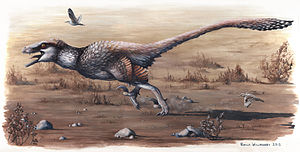Emily Willoughby
| Emily Willoughby | |
|---|---|
 Emily_willoughby_in_2019.jpg Emily_willoughby_in_2019.jpg | |
| Born | |
| 🏳️ Nationality | American |
| 🏫 Education | Thomas Edison State University (BA) University of Minnesota (MA, PhD) |
| 🎓 Alma mater | University of Minnesota Twin Cities[1] |
| 💼 Occupation | |
| Known for | Paleoart, illustration, psychology research |
| 🌐 Website | emilywilloughby |
Emily Willoughby (born November 17, 1986)[3] is an American paleoartist, illustrator, writer, and postdoctoral researcher in behavior genetics living in Minneapolis, Minnesota. Willoughby is best known for her scientific illustrations of maniraptoran dinosaurs.[4]
Education[edit]
She won the International Society for Intelligence Research Prize for Best Student Paper in 2017[5] and 2019,[6] where she currently sits as a board member as of 2020.[7]
Illustration[edit]

She has done illustrations of birds, dromaeosaurids, theropods for scientific papers, most notably of Dakotaraptor steini in 2015.[8] She has also illustrated ceratopsian dinosaurs and ankylosaurians for the nonprofit Institute for the Study of Mongolian Dinosaurs.[9][better source needed] Willoughby's work has appeared in Paul Barrett and Darren Naish's Dinosaurs: How They Lived and Evolved 2016,[10] the Shanghai Natural History Museum, and the journal Nature.[11][better source needed]
Writing[edit]
Willoughby, along with Jonathan Kane, T. Michael Keesey, Glenn Morton and James Comer, authored God's Word or Human Reason?,[12] a 2017 book detailing the relationship between religion and science, in which the authors argue that there is no need for a Christian lifestyle to be incompatible with scientific consensus. Many of the authors talk about their former creationist lifestyles and beliefs throughout the book.[13]
References[edit]
- ↑ "UMN College of Liberal Arts Staff Directory". umn.edu. 19 April 2021. Retrieved 19 April 2021.
- ↑ "University of Minnesota College of Liberal Arts: Recent Graduates". 19 April 2021. Archived from the original on 2021-04-19. Retrieved 19 April 2021.
- ↑ "Willoughby, Emily". Library of Congress Name Authority File. Retrieved 2019-06-17.
- ↑ Terakado, Kazuo (2017). The Art of the Dinosaur. PIE International. pp. 159–177. ISBN 978-4756249227. Search this book on

- ↑ "2017 ISIR Prize for Best Student Paper: Emily Willoughby". isironline.org. International Society for Intelligence Research. July 27, 2017. Retrieved December 19, 2017.
- ↑ "2019 ISIR Prize for Best Student Paper: Emily Willoughby". isironline.org. International Society for Intelligence Research. October 26, 2020. Archived from the original on October 26, 2020. Retrieved April 19, 2021.
- ↑ "ISIR Board Members". isironline.org. International Society for Intelligence Research. Archived from the original on November 28, 2020. Retrieved April 19, 2021.
- ↑ White, Steve (2017). Dinosaur Art II. Titan Books. pp. 42–57. ISBN 978-1785653988. Search this book on

- ↑ "Institute for the Study of Mongolian Dinosaurs". Retrieved December 8, 2017.
- ↑ Naish, Darren; Barrett, Paul (2016). Dinosaurs: How They Lived and Evolved. The Natural History Museum. ISBN 978-0565093112. Search this book on

- ↑ "2015 Darwin Week in Charleston". Retrieved April 19, 2021.
- ↑ Spence, Steven (14 February 2017). "Book Review: God's Word or Human Reason?". GotScience.org.
- ↑ Kane, Jonathan; Willoughby, Emily; Keesey, T. Michael (2017). God's Word or Human Reason?. Inkwater Press. ISBN 978-1629013725. Search this book on

External links[edit]
- Official website
- Emily Willoughby publications indexed by Google Scholar
This article "Emily Willoughby" is from Wikipedia. The list of its authors can be seen in its historical and/or the page Edithistory:Emily Willoughby. Articles copied from Draft Namespace on Wikipedia could be seen on the Draft Namespace of Wikipedia and not main one.
